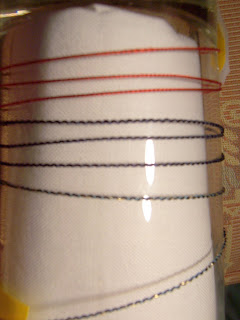
My mum has a small piece of green Aida decorated with cross stitch that one of my brothers or myself stitched at infant school. It was always on display on top of the TV until they bought a new TV that has a black plastic moulded top that you can’t display things on. I wonder where it is now! When I visit her on Thursday, I must ask who stitched it and take a fresh look at it.
I’ve done a few counted cross stitch kits, including a bell pull with an owl and cherry blossoms that my Dad asked me to do. It took me ages and I might not have completed it but Dad rarely asks for anything so I really wanted to finish it for him.
I have seen some beautiful examples of cross stitch but never really thought the stitch itself to be very exciting until I bought a book called The Liberated Canvas by Penny Cornell. I love this book; it did make me look at canvas work in a whole new light but I have never gotten around to experimenting with some of the ideas in it. I’m not a liberated stitcher. I have a neat orderly mind that refuses to do random, so instead of just giving it ago, I agonise over HOW to do random.
When cross stitch came up for week 9 of
TAST, I was determined to be liberated. I started cautiously with regular stitches worked in vertical rows but mixing colours, threads and sizes within the rows. I am quite pleased with the result, it has an organic look and I like the subtle colour changes. It reminds me of stalactites.
I also wanted to experiment with irregular stitches. I tried hard to just stitch, constantly changing colours and threads; altering the size and shape of the stitches. Whilst I succeeded in doing that, I don’t think the result is a success. As I was stitching, J said that it looked like a mish-mash and I agree with him.
I look at random ‘pictures’ created by textile artists and I see beauty. This may sound daft, but there is usually some order to their work, the way the colours flow through it, for example. I look at my little sample and I see a mess, there is no focal point, no flow or movement. NO DESIGN. I don’t think this is a case of me being over critical of my own work. I try to be objective, especially in the case of
TAST, which I view as a learning process. If anyone has any thoughts on how to make random a success, I would be interested to hear them.
Happy Stitching
 Having gone on about all the exciting things that you can couch, you may be disappointed to see that I have used none of these. I have established a theme for my TAST projects and I like to stay "on theme". The central circle is bayeaux stitch; the layer of satin stitch is held by perpendicular rows of couched thread. The circle is outlined by strung beads, the thread is couched between the beads. The lattice is simply perpendicular rows of laid thread couched where they intersect with small crosses. The other circle is a pair of threads (tapestry wool) couched in a spiral and the border is narrow satin ribbon couched with a combination of Cretian and Chevron stitches.
Having gone on about all the exciting things that you can couch, you may be disappointed to see that I have used none of these. I have established a theme for my TAST projects and I like to stay "on theme". The central circle is bayeaux stitch; the layer of satin stitch is held by perpendicular rows of couched thread. The circle is outlined by strung beads, the thread is couched between the beads. The lattice is simply perpendicular rows of laid thread couched where they intersect with small crosses. The other circle is a pair of threads (tapestry wool) couched in a spiral and the border is narrow satin ribbon couched with a combination of Cretian and Chevron stitches.



















